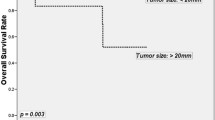Abstract
Background
Endoscopically, rectal carcinoids have a variety of sizes and features which may assist in determining treatment plans. The present study was performed to assess the relationship between endoscopic features and metastasis in rectal carcinoids.
Methods
A total of 115 rectal carcinoids of 112 patients with rectal carcinoids were enrolled, and the medical records were retrospectively reviewed. All tumors were classified according to size (longest diameter), and then according to endoscopic features such as shape, color, and surface changes including depressions, erosion, and ulceration. The relationship between endoscopic features and metastasis was evaluated.
Results
11 cases (9.6%) of the 115 rectal carcinoids presented with metastatic disease. Tumor size was associated with metastasis (p < 0.001). Endoscopic features associated with metastasis were tumor shape, surface change, and color (p < 0.001). Atypical endoscopic features occurred more frequently as the size of the tumor increased (p < 0.001). For tumors 10–19 mm in diameter, atypical surface change was associated with metastasis (p = 0.007).
Conclusions
Endoscopic features were found to be associated with metastasis in rectal carcinoids. In particular, atypical surface change may be useful in determining treatment plans for tumors 10–19 mm in diameter.


Similar content being viewed by others
References
Fahy BN, Tang LH, Klimstra D, Wong WD, Guillem JG, Paty PB, Temple LK, Shia J, Weiser MR (2007) Carcinoid of the rectum risk stratification (CaRRs): a strategy for preoperative outcome assessment. Ann Surg Oncol 14:1735–1743
Kobayashi K, Katsumata T, Yoshizawa S, Sada M, Igarashi M, Saigenji K, Otani Y (2005) Indications of endoscopic polypectomy for rectal carcinoid tumors and clinical usefulness of endoscopic ultrasonography. Dis Colon Rectum 48:285–291
Rorstad O (2005) Prognostic indicators for carcinoid neuroendocrine tumors of the gastrointestinal tract. J Surg Oncol 89:151–160
Soga J (1997) Carcinoids of the rectum: an evaluation of 1271 reported cases. Surg Today 27:112–119
Modlin IM, Kidd M, Latich I, Zikusoka MN, Shapiro MD (2005) Current status of gastrointestinal carcinoids. Gastroenterology 128:1717–1751
Wang AY, Ahmad NA (2006) Rectal carcinoids. Curr Opin Gastroenterol 22:529–535
Koura AN, Giacco GG, Curley SA, Skibber JM, Feig BW, Ellis LM (1997) Carcinoid tumors of the rectum: effect of size, histopathology, and surgical treatment on metastasis free survival. Cancer 79:1294–1298
Heah SM, Eu KW, Ooi BS, Ho YH, Seow-Choen F (2001) Tumor size is irrelevant in predicting malignant potential of carcinoid tumors of the rectum. Tech Coloproctol 5:73–77
Okumura Y, Maruta M, Maeda K, Utsumi T, Tohyama K, Sato H, Masumori K, Matsumoto M, Koide Y, Ishihara O, Matsuoka H, Nogaki M (1997) Minute carcinoid tumor in the rectum with liver metastasis. Gan To Kagaku Ryoho 24(Suppl 2):307–312
Tsuboi K, Shimura T, Suzuki H, Mochiki E, Haga N, Masuda N, Soda M, Yamamoto H, Asao T, Kuwano H (2004) Liver metastases of a minute rectal carcinoid less than 5 mm in diameter: a case report. Hepatogastroenterology 51:1330–1332
Shim KN, Yang SK, Myung SJ, Chang HS, Jung SA, Choe JW, Lee YJ, Byeon JS, Lee JH, Jung HY, Hong WS, Kim JH, Min YI, Kim JC, Kim JS (2004) Atypical endoscopic features of rectal carcinoids. Endoscopy 36:313–316
Jetmore AB, Ray JE, Gathright JB Jr, McMullen KM, Hicks TC, Timmcke AE (1992) Rectal carcinoids: the most frequent carcinoid tumor. Dis Colon Rectum 35:717–725
Matsui K, Iwase T, Kitagawa M (1993) Small, polypoid-appearing carcinoid tumors of the rectum: clinicopathologic study of 16 cases and effectiveness of endoscopic treatment. Am J Gastroenterol 88:1949–1953
Saito Y, Kondo H, Yokota T, Fujii T, Ono H, Gotoda T, Takigawa T, Saito D, Ishikawa T, Akasu T, Shimoda T (2000) A rectal carcinoid macroscopically simulating early cancer. Endoscopy 32:S17–S18
Okamoto Y, Fujii M, Tateiwa S, Sakai T, Ochi F, Sugano M, Oshiro K, Masai K, Okabayashi Y (2004) Treatment of multiple rectal carcinoids by endoscopic mucosal resection using a device for esophageal variceal ligation. Endoscopy 36:469–470
Hunerbein M (2003) Endorectal ultrasound in rectal cancer. Colorectal Dis 5:402–405
Higaki S, Nishiaki M, Mitani N, Yanai H, Tada M, Okita K (1997) Effectiveness of local endoscopic resection of rectal carcinoid tumors. Endoscopy 29:171–175
Acknowledgements
This work was supported in part by the National Cancer Center Grant (NCC-0710362).
Author information
Authors and Affiliations
Corresponding author
Rights and permissions
About this article
Cite this article
Kim, B.N., Sohn, D.K., Hong, C.W. et al. Atypical endoscopic features can be associated with metastasis in rectal carcinoid tumors. Surg Endosc 22, 1992–1996 (2008). https://doi.org/10.1007/s00464-008-0006-x
Received:
Accepted:
Published:
Issue Date:
DOI: https://doi.org/10.1007/s00464-008-0006-x




